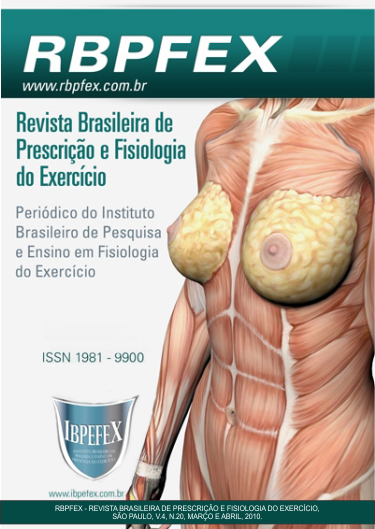Discrepancies between concentric and eccentric muscle actions strength
Abstract
The aim of this study was to observe the discrepancies between concentric and eccentric muscle actions strength in the tests of one repetition maximum concentric (1RMcon) and one repetition maximum eccentric (1RMexc) for the bench press (BP), Leg Press 45 ° (LP), and Seated Cable Rows (RC). Participated in the study 16 healthy young adults (9 men - age = 23.4 ± 3 years, mass = 74.2 ± 9.9 kg, height = 1.76 ± 0.06m.7 women - age = 25.4 ± 1.5 years, mass = 60.5 ± 9.1KG, height = 1.67 ± 0.06m). 1RMcon and 1RMexc loads were verified in 2 distinct sessions, and separated by one week each. Statistical analysis was performed using a two-way ANOVA with post test Tukey and Kramer multiple comparison test was adopted as a benchmark significant p <0.05. We observed that the 1RMexc loads were significantly higher (p <0.01) than those of 1RMcon in the 3 exercises analyzed. For the LP the difference was 53%, for the BP 70%, and the RC 62% higher. The observed data supported our hypothesis and further emphasize the importance of distinguishing the intensity used for the eccentric muscle actions in strength training.
References
- Barstow, I.K.; Bishop, M.D.; e colaboradores. Is enhanced-eccentric resistance training superior to traditional training for increasing elbow flexor strength? Journal of Sports Science and Medicine. Num. 2. 2003. p. 62-69.
- Brown, L.E.; Weir, J.P. ASEP Procedures recommendation I: accurate assessment of muscular strength and power. Num. 4. 2001. p. 1-21.
- Campos, G.E.; Luecke, T.J.; e colaboradores. Muscular adaptations in response to three different resistance-training regimens: specificity of repetition maximum training zones. Eur J Appl Physiol. Vol. 88. Num. (1-2). 2002. p. 50-60.
- Doan, B.K.; Newton, R.U.; e colaboradores. Effects of increased eccentric loading on bench press 1RM. J Strength Cond Res. Vol. 16. Num. 1. 2002. p. 9-13.
- Dudley, G.A.; Tesch, P.A.; e colaboradores. Importance of eccentric actions in performance adaptations to resistance training. Aviat Space Environ Med. Vol. 62. Num. 6. 1991. p. 543-550.
- Friden, J.; Lieber, R.L. Eccentric exercise-induced injuries to contractile and cytoskeletal muscle fibre components. Acta Physiol Scand. Vol. 171. Num. 3. 2001. p. 321-326.
- Friedmann, B.; Kinscherf, R.; e colaboradores. Muscular adaptations to computer-guided strength training with eccentric overload. Acta Physiol Scand. Vol. 182. Num. 1. 2004. p. 77-88.
- Glaister, M. Multiple sprint work: physiological responses, mechanisms of fatigue and the influence of aerobic fitness. Sports Med. Vol. 35. Num. 9. 2005. p. 757-777.
- Hather, B.M.; Tesch, P.A.; e colaboradores. Influence of eccentric actions on skeletal muscle adaptations to resistance training. Acta Physiol Scand. Vol. 143. Num. 2. 1991. p. 177-185.
- Herzog, W.; Lee, E.J.; e colaboradores. Residual force enhancement in skeletal muscle. J Physiol. Num. 574(Pt 3). 2006. p. 635-642.
- Hollander, D.B.; Kraemer, R.R.; e colaboradores. Maximal eccentric and concentric strength discrepancies between young men and women for dynamic resistance exercise. J Strength Cond Res. Vol. 21. Num. 1. 2007. p. 34-40.
- Hortobagyi, T.; DeVita, P. Favorable neuromuscular and cardiovascular responses to 7 days of exercise with an eccentric overload in elderly women. J Gerontol A Biol Sci Med Sci. Vol. 55. Num. 8. 2000. p. B401-410.
- Hortobagyi, T.; Devita, P.; e colaboradores. Effects of standard and eccentric overload strength training in young women. Med Sci Sports Exerc. Vol. 33. Num. 7. 2001. p. 1206-1212.
- Kraemer, W.J.; Fry, A.C. Strength testing: development and evaluation of methodology. 1995.
- Ojasto, T.; Hakkinen, K. Effects of different accentuated eccentric load levels in eccentric-concentric actions on acute neuromuscular, maximal force, and power responses. J Strength Cond Res. Vol. 23. Num. 3. 2009. p. 996-1004.
- Ojasto, T.; Hakkinen, K. Effects of different accentuated eccentric loads on acute neuromuscular, growth hormone, and blood lactate responses during a hypertrophic protocol. J Strength Cond Res. Vol. 23. Num. 3. 2009a. p. 946-53.
- Rassier, D.E.; Herzog, W. Force enhancement and relaxation rates after stretch of activated muscle fibres. Proc Biol Sci. Vol. 272. Num. 1562. 2005. p. 475-80.
- Rassier, D.E.; Herzog, W. Relationship between force and stiffness in muscle fibers after stretch. J Appl Physiol Vol. 99. Num. 5. 2005. p. 1769-1775.
- Rassier, D.E.; MacIntosh, B.R.; e colaboradores. Length dependence of active force production in skeletal muscle. J Appl Physiol. Vol. 86. Num. 5. 1999. p. 1445-1457.
- Smith, L.L.; Anwar, A.; e colaboradores. Cytokines and cell adhesion molecules associated with high-intensity eccentric exercise. Eur J Appl Physiol. Vol. 82. Num. (1-2). 2000. p. 61-67.
- Toigo, M.; Boutellier, U. New fundamental resistance exercise determinants of molecular and cellular muscle adaptations. Eur J Appl Physiol. Vol. 97. Num. 6. 2006. p. 643-663.
Authors who publish in this journal agree to the following terms:
- Authors retain the copyright and grant the journal the right of first publication, with work simultaneously licensed under the Creative Commons Attribution License BY-NC which allows the sharing of the work with acknowledgment of the authorship of the work and initial publication in this journal.
- Authors are authorized to enter into additional contracts separately for non-exclusive distribution of the version of the work published in this journal (eg, publishing in institutional repository or book chapter), with acknowledgment of authorship and initial publication in this journal.
- Authors are allowed and encouraged to post and distribute their work online (eg, in institutional repositories or on their personal page) at any point before or during the editorial process, as this can bring about productive change as well as increase impact and impact. citation of published work (See The Effect of Free Access).






